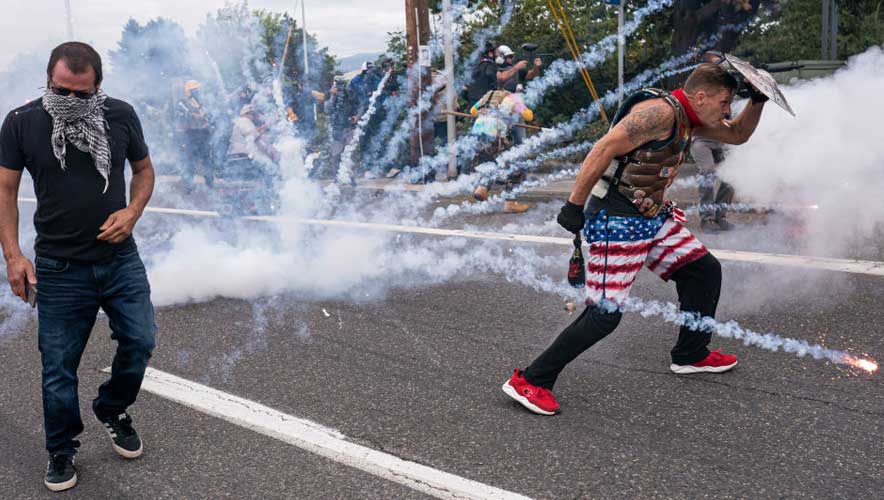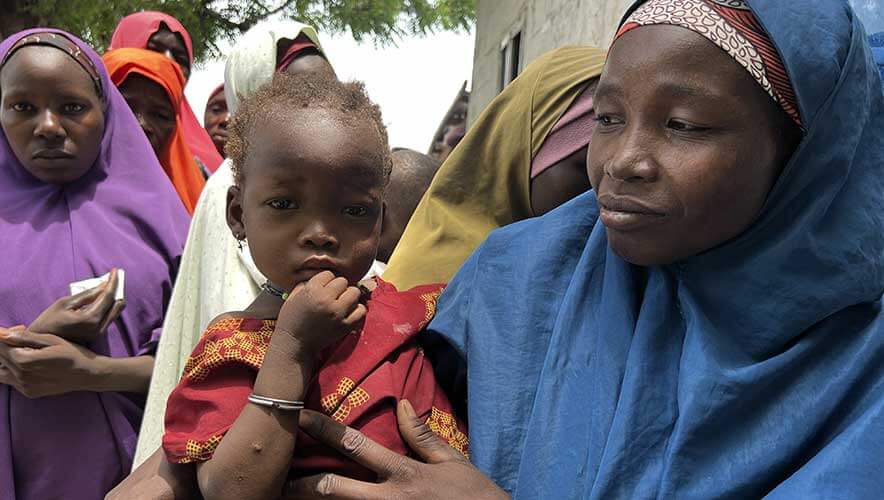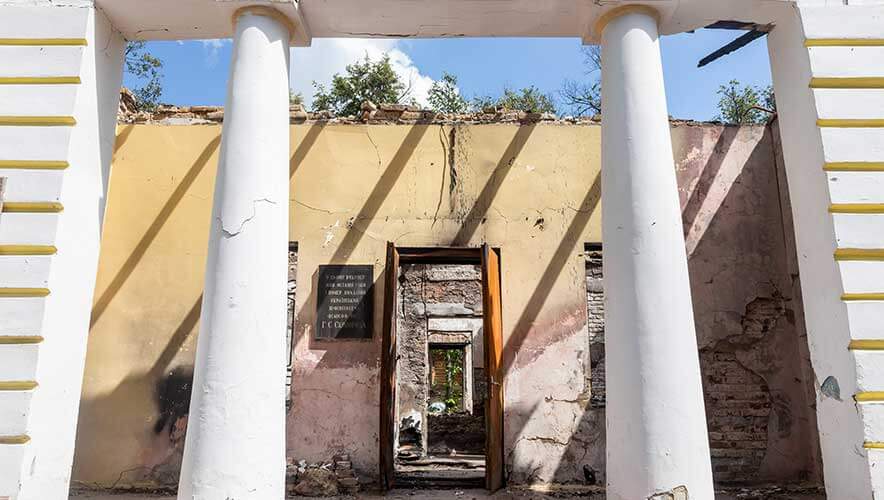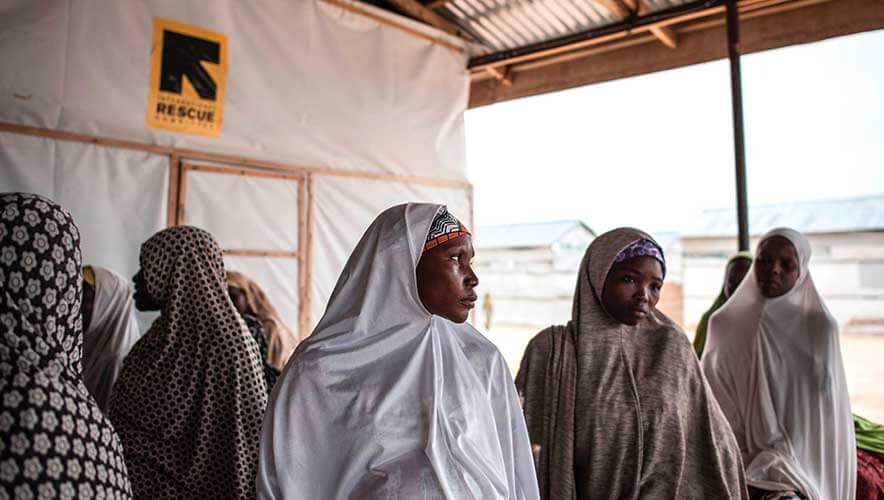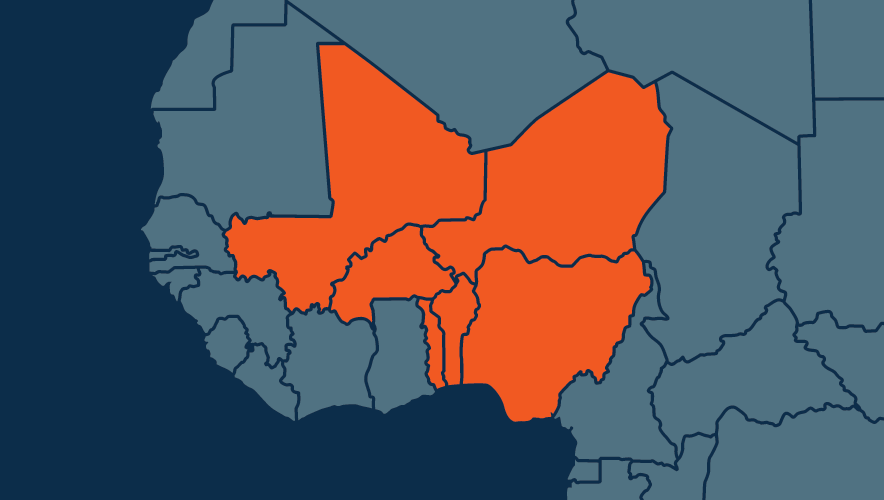Options-Based Responses to Violent Threats Against Schools
Every day, millions of parents send their children to school with the belief that they will learn and be kept safe. Parents already face concerns about active assailant incidents at schools, but nothing would shatter their feelings of safety more rapidly than coordinated terror attacks on multiple soft targets such as schools or school buses.
Terrorism is generally defined as the use of violence in the pursuit of political or social objectives. While not all terrorism attacks involve active shooters and not all active shooter incidents meet the definition of terrorism, both can be described as violent critical incidents (VCI).
When the perpetrator of a VCI is a student, warning signs are often prevalent, and intervention through behavioral threat assessment and management provides a strong opportunity for prevention. When the attacker is an outsider, the school must rely on physical security to deter the attack, deny entry into the school, and hopefully delay the attacker’s access to students and staff.
Considering the unimaginable loss school shootings have created, it is difficult to say that a terror attack would be more catastrophic. But where school preparedness is concerned, the comparison is unnecessary if a district develops a holistic approach to VCI preparedness, prevention, and response.
Schools Form High-Value Targets
A soft target is generally defined as a location that is easily accessible and unprotected, and schools are often the ultimate soft targets. When attempting to predict the probability of a terror attack on a soft target like a school, it helps to understand the terrorists’ thought processes.
Many terrorists intend to create chaos through brutality. The monograph Management of Savagery: The Most Critical Stage Through Which the Islamic Nation Will Pass by al Qaeda affiliate Abu Bakr Naji bears the hallmarks of this ideology. Management of Savagery teaches that success is achieved by enacting a vicious campaign that decays government stability. This chaos creates an opportunity to enact social changes that are more stable than the savagery, thereby bringing about the terrorists’ desired outcome.
For a terrorist organization that follows these teachings, it is hard to think of a target that is more attractive than a school, and this type of attack is hardly unprecedented.
The 7 October 2023 Hamas terrorism attacks in Israel targeted, among other places, a music festival and a nursery. In June 2023, approximately 20 members of the Islamic State-linked Allied Democratic Forces (ADF) rebel group attacked a secondary school in Uganda and killed 39 students. In April 2015, terrorists associated with al Qaeda offshoot al Shabaab stormed Garissa University in Kenya, murdering 147 people during a 15-hour siege. In April 2014, Boko Haram terrorists abducted 276 schoolgirls from a town in western Nigeria.
These attacks confirm that schools are high-value soft targets for terrorists.
Target Selection: Risk versus Reward
Many terrorists leverage a multiple target strategy when planning attacks. This concept accepts that some elements of an attack will fail, but those failures are acceptable as long as one of the attacks succeeds. This warped definition of success and level of commitment presents extraordinary challenges for security professionals.
The multiple target strategy emphasizes the importance of succeeding in at least some part of an attack. From a terrorist standpoint, a successful attack is the reward. Failure, not death, is the risk. When considering a target, the determination of probability of success or reward has many factors.
The assessment charts below illustrate how a typical elementary school compares to traditional high-value targets in the United States.
Target Value
In the first chart, reward elements are scored 1 through 10, with 10 representing the greatest reward to the attacker. These factors include:
- Death and injury. How many people will be harmed by the attack?
- Economic impact. What is the fiscal toll from the attack?
- Impact on infrastructure. How will the attack impact daily lives?
- Symbolic effect. Will attacking this target shock the public?
Value is determined by weighing those four criteria.
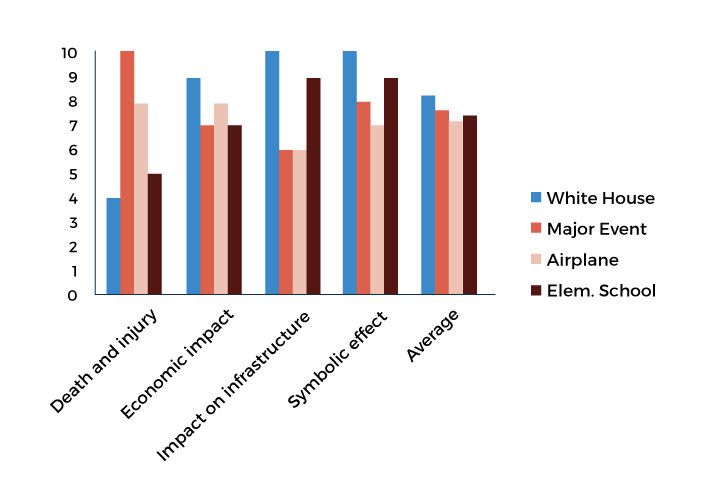
Target Risk
Similarly, there are many aspects to failure or risk. Risk elements are also scored 1 through 10, with 10 representing the greatest risk to the attacker and thereby a lower probability of success. These include:
- Physical security. How well is access managed?
- Law enforcement. Are police on-site? What are the average response times?
- Planning. What level of emergency planning is in place?
- Training. Are staff trained and prepared to respond to an attack?
- Situational awareness. What is the level of vigilance?
Risk is determined by security measures to safeguard targets.
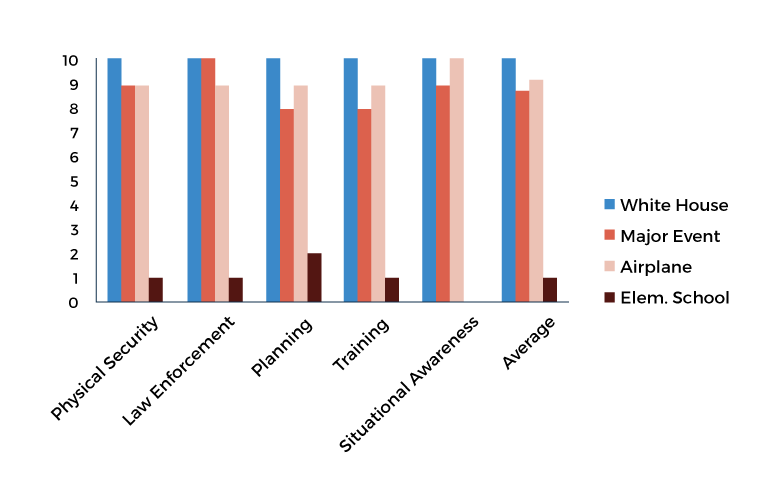
Target Selection
After all elements of a potential target are scored, the reward is divided by the risk to produce a target value. When applied to multiple locations, this assessment can identify which targets have the greatest value to a potential attacker. Typically, this type of critical assessment is applied to potential targets within a limited geographical area.
Selection is determined by dividing value by risk.
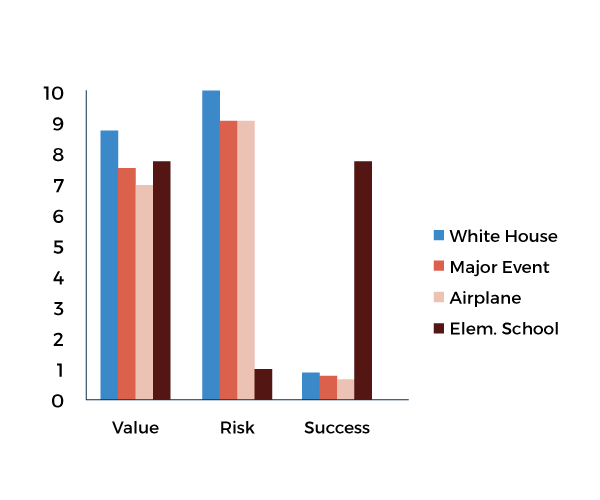
The value of a school combined with the low risk of the attack being prevented lead to a high likelihood of a successful attack against a typical elementary school.
Refocus on Prevention and Response
The ideal time to enhance preparedness and situational awareness is before an attack, not after one. A foundation for this emerging reality already exists in comprehensive all-hazards emergency preparedness programs.
While recovery efforts and family reunification are important, not all elements of preparedness are equal. Recently, many school districts have increased their focus on recovery by conducting family reunification exercises, but they are conducting these scenarios without having practiced prevention and response. If reunification goes poorly, the district will suffer from disgruntled parents and negative press. But when prevention and response fail, lives are lost.
Consider prioritizing these holistic security steps by focusing on prevention, risk mitigation, and response.
Prevention
- Ensure that education is represented within terrorism-related information sharing programs.
- Encourage people to report potential radicalization and other concerning behavior via tip programs.
- Use risk assessment programs to establish minimum security standards for schools.
- Launch deterrence media campaigns that promote a school’s collaboration with law enforcement, active shooter response training, and situational awareness.
Mitigation and Response
- Implement options-based response training programs such as ALICE (alert, lockdown, inform, counter, evacuate) or Run. Hide. Fight.
- Enact comprehensive emergency plans that do not rely on generic standard response protocols.
- Station law enforcement officers on-site.
- Provide law enforcement access to school site mapping data.
- Conduct VCI exercises with local law enforcement agencies that test both school and law enforcement response protocols.
Applying Options
Lessons learned from previous active shooter attacks led the U.S. Department of Homeland Security and Department of Education to recommend that schools move beyond a simple lockdown plan and integrate survival options, such as ALICE or Run. Hide. Fight. protocols, into their plans and training.
Survival options are not only an active shooter response best practice, but options also represent the best mitigation strategy to a school terror attack. Lockdown alone will simply facilitate hostage taking and enable the attackers to focus on thwarting law enforcement response.
Options are not in and of themselves a curriculum. As with all emergency plans, these options require training to help staff understand when and how they should be implemented. When training is done correctly, survival options empower staff and older students to make lockdown or evacuation decisions. This requires training and an understanding that reliance upon a schoolwide standard response protocol can increase casualties during dynamic situations like an active assailant or terrorist attack.
Lockdown versus evacuation response is based on two key factors: your proximity to the threat (contact) and your location, as well as any key responsibilities an individual may have (such as helping students with special needs who may be unable to evacuate quickly). The formula is: Contact + Location = Response.
Contact
- Direct contact. There are no barriers between your location and the assailant. The assailant poses an immediate danger.
- Indirect contact. The assailant is inside or near your facility or in your general area, but distance or barriers delay the assailant’s ability to harm you.
Location
- Securable location. This location can provide a degree of protection from an attacker. This includes rooms with doors that may be secured and have minimal interior windows from the hallway to the room. A securable location may be conducive to a lockdown
- Nonsecurable location. This location offers no protection from an assailant. This includes hallways or common spaces that do not have doors that could be secured. A nonsecurable location does not deny access and is not conducive to a lockdown.
|
Contact |
Location |
Response |
|
Direct Contact |
Irrelevant |
Evacuate (Counter or Fight as Last Resort) |
|
Indirect Contact |
Securable |
Lockdown or Evacuate if Route is Safe |
|
Indirect Contact |
Nonsecurable |
Evacuate |
A robust program that prepares schools and response agencies for a coordinated terrorist attack (or attacks) will certainly better equip schools and response agencies to better manage all emergencies. Educators and response agencies must prepare for a new level of response to confront a terrorist takeover situation. The dynamic nature of incidents and terrorists’ commitment requires enhanced plans and training.
A coordinated terrorist attack is a worst-case scenario, and planning response requires a paradigm shift from the traditional lockdown-only mentality. Rather than attempting to immediately enter classrooms, the attackers will attempt to fortify entrances to thwart police response. If police are delayed, a locked classroom door will be all that remains between a terrorist and students. That will not be enough.
Brad Spicer is national director of safety preparedness and emergency management for Navigate360. Since 2000, Spicer has focused on helping protect good people from bad things. His background in the military, law enforcement, preparedness, technology, and survival training fueled the advancement of emergency management software platforms and training programs. He has helped numerous U.S. states and school systems identify risks and develop all-hazards preparedness programs.


